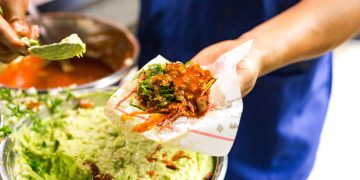
Frank Sabatini Jr. | Restaurant Review
If I were given a shot of tequila for every time someone asked me where to go for an upscale Mexican meal in San Diego, my liver would have disintegrated by now. Other than steering people to Candelas and a few slightly less-formal places, the pickings are slim.
 As of last week, however, I added El Agave Restaurant and Tequileria to the list. Located above a liquor store at the south end of San Diego Avenue’s main commercial drag, the restaurant’s cozy, enticing ambience goes easily undetected, as does its penchant for fine tequilas and opulent mole sauces.
As of last week, however, I added El Agave Restaurant and Tequileria to the list. Located above a liquor store at the south end of San Diego Avenue’s main commercial drag, the restaurant’s cozy, enticing ambience goes easily undetected, as does its penchant for fine tequilas and opulent mole sauces.
At the top of the stairs is an intimate pub-like bar as well as the first of many wooden shelving units crammed with tequilas. The collection infiltrates the entire restaurant in a sparkling exhibit showing off bottles of every shape, size and color.

The ownership claims to house more than 2,000 brands, a believable declaration despite that only a couple hundred of them are listed on the menu. Still, the choices are dizzying as they encompass tequila’s three main categories: the blancos, reposados and anejos.
They’re served in two-ounce pours starting at $5.75 and climbing to $175 for connoisseurs bent on twice-distilled 1800 Coleccion, for example, which is touted for its soft, almond-y flavor.
Visiting as a twosome on a weeknight, we passed on acquiring the inevitable buzz that comes with sipping distilled agave and B-lined to the food menu instead. But next time for sure.
Chalupas de Langosta is a specialty dish common in the Mexican states of Puebla and Oaxaca. It appears on the menu as an appetizer involving a pair of dense masa ovals topped with lobster pieces, artichokes, diced tomatoes and crumbled white cheese. They were hearty and delightful.
A similar starter that we didn’t try — tlacoyos cuitlacoche — uses blue masa to showcase a filling of black beans, corn fungus and queso fresco. In either case, neither dish typifies San Diego-style Mexican food, which is partly why people come here.
Another appetizer of mini quesadillas (served four to an order) were deliciously novel, thanks to nutty-tasting manchego cheese, roasted poblano peppers, sautéed mushrooms and wisps of shredded chicken folded inside. Chipotle crème fraiche on top added extra zip.
From two types of ceviche available, we ordered the “del mar” version capturing generous chunks of shrimp and octopus bathed in a nicely chilled medley of tomatoes, baby corn, red bell peppers, olive oil and fresh lemon juice. The other, called cevichelo, is the almost-vegetarian option using Portobello mushrooms instead of fish. But it also contains tomato juice infused with clams.
Our next course featured a Tijuana-style Caesar, served accurately in whole-leaf form and with a tad of Worcestershire sauce in the dressing. But the single crouton in the mix left me yearning for that classic crunch.
My companion’s ahi salad was technically a mound of beautiful tuna tartare plated alongside fresh, lightly dressed greens. Lots of citrus and cilantro emerged from the velvety tuna, making it impossible to stop eating.

Ten different mole dishes are grouped into a single category on the entrée menu, which also includes sections for seafood, steaks and lamb. Mole, known sometimes as “the curry of Mexico,” is an earthy, complex sauce made typically with myriad spices, nuts and hints of chocolate. Their recipes vary wildly throughout Mexico, although rarely do we see multiple versions of it on a single menu.
Served over chicken or pork, I gravitated initially to rosa de taxco, a pink mole that gets its rosy color from white chocolate and beets. But when our waiter informed me that it’s among the sweetest, I decided to try the mole rojo instead, a spicier recipe highlighting guajillo peppers, garlic and bananas and sans any chocolate.
The flavor combination was astounding — deep, rich and zesty enough to turn a boneless, skinless chicken breast into a memorable event.
Other mole choices include the nut-heavy negro made also with raisins; pipian infused with pumpkin seeds; verde made with tomatillos and Serrano chilies; and Coloradito, which is similar to the rojo but with chocolate.

In lieu of mole, my companion chose New Zealand rack of lamb accented with herbs and ancho chilies and served over buttery mashed potatoes. A puddle of hibiscus flower reduction on the plate lent tang and originality to the dish.
We concluded with Mexican chocolate crème brulee and moist tres leches cake, both made flawlessly in-house.
El Agave has been in Old Town for 17 years and recently opened a second kitchen in Del Mar at 1555 Camino Del Mar, where the tequila inventory is reportedly catching up with this location.













Discussion about this post